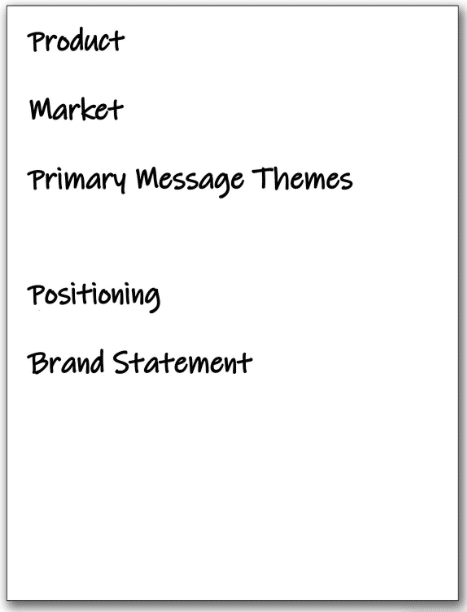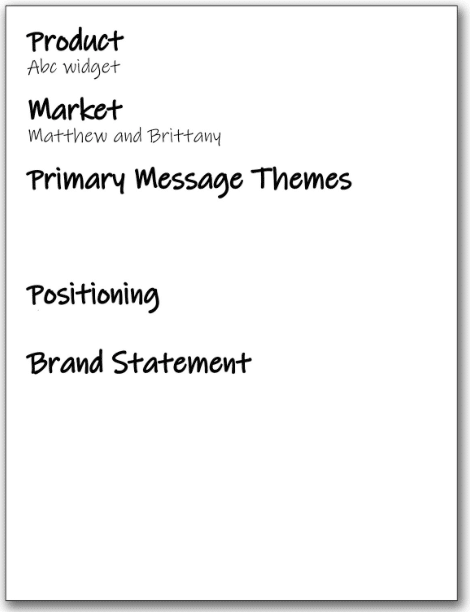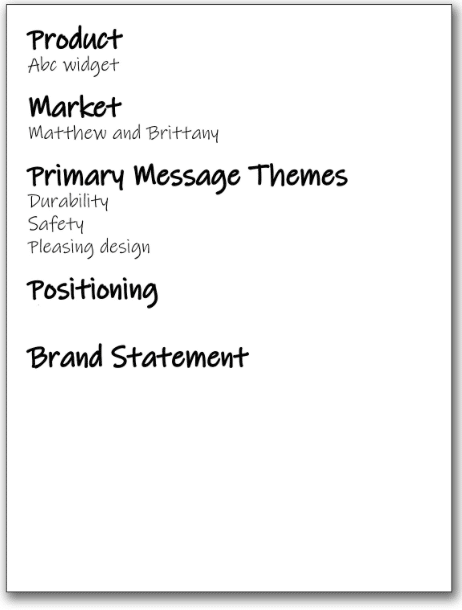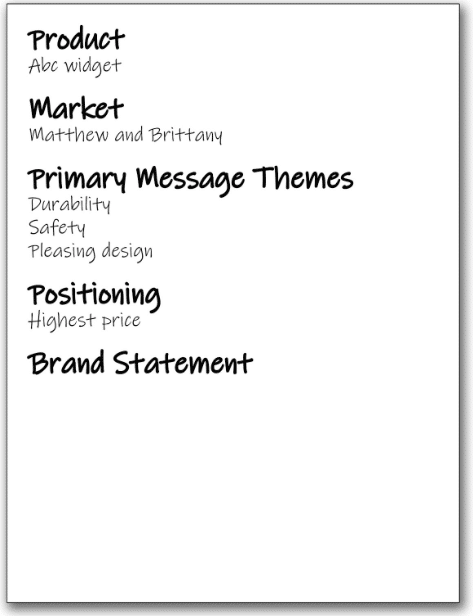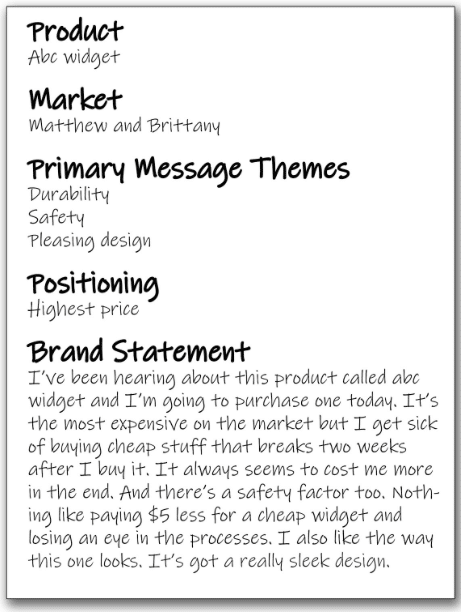I cringe when I read what is written about marketing, andespecially branding. Most of it is BS written by people who have no idea what they are talking about. You can always tell how little these navel gazers know about marketing by how much they throw around the word “brand.” When someone boasts about being a brandingexpert, it’s a good idea to get as far away from them as possible.
In this article,I’m going to explain marketing simply andgive you some step-by-step instructions that will adjust what you are doing so you’ll sell more stuff. Here we go.
Grab a notebookand pencil because I’m going to start by walkingyou through creating what I call Code Sheets. These will be used every time you do any marketing whether it’s building a website, running some ads, creating social posts or being interviewed by the media. They are a godsend for keeping your message on point.
Marketing is all aboutwho buys and why. You no doubt already havea good idea who these people are and what will cause them to purchase your product. So, let’s capture, codify and organize that information so you, and your team if you have one, don’t have to hold it all in your head or have it scattered here and there. Iuse Google slides for my Code Sheets but just work along with me and scratch one out on paper for now. You can polish your Code Sheets later.
On a single sheet of paper,write down these headings andleave room to write underneath them: Product, Market, Primary message theme, Positioning and Brand Statement. Like this:
Product
This one’s easy.Under Product, write the name of one of theproducts or services you offer. In marketing, we don’t distinguish between products and services. We just use the word product. In my example, I’ll use the product ABC widget. We are just going to work on one Code Sheet for now but you may end up with multipleCode Sheets as you’ll see in the next step.
Market
People get all jazzed aboutdividing their market into submarkets.That’s a mistake. It’s much more cost efficient to sell to your market as one big group if you can. If you can’t, you can’t. But try to keep it to as few submarkets as possible. The rule of thumb is don’t segment a market unless you absolutely have to say different things to different groups.
A good trick is toname your market (or submarkets if youdivide your market). The way to do this is to first build a profile of the group using these categories: demographics (like age, gender, family life cycle, etc.), geographics (like rural, big city, east coast, etc), benefits sought, product usage rate (constantor infrequent users) psychographics (how people think like Joe Sixpack or a wine snob).
Once you create a profile, estimate their average age and thenGoogle the most common names for the year they were born. If the average age for our ABC widget prospective customer is 40, a Google search will show that Matthew and Brittany were among the most popular baby names 40 years ago. So that’s what we’ll name ourABC widget’s market: Mathew and Brittany.
Once you know who someone is, their name is a trigger for recollection.Pick anyone you know and say their name. One little name and you have an instant awareness of the sum of who they are. That’s what will happen when you build a profile of a market and name it. You won’t have to stop and think about their profile, you will automaticallyknow it.
So, build your market profile(s), and name them. Note thatyou will be creating one Code Sheet for each product and if the product has multiple submarkets you will have multiple Code Sheets for that product. For example, if you have one product with two submarkets, you’ll have two Code Sheets. If you have three productsand each product has three submarkets, you will have nine Code Sheets. Get it? Right now, we’re just working on one.
At this point your Code Sheet should look like this:
Primary Message Themes
There are likely many different reasonspeople buy your product, but some reasons will be more common than others. When you communicate with groups it makes sense to focus on the most common one, two or maybe three main reasons people buy. If you find yourself getting bored repeating the same old points over and over, andover, and over, you are doing marketing right.
In marketing speak, the main reasons people buy are calledPrimary Value Points. The less common reasons people buy are called Secondary Value Points. Think of your marketing communications like a movie or a novel. You have main characters (Primary Value Points) who are in the story all the time, and supporting characters(Secondary Value Points) who show up once in a while.
You want to remain awarewhen you are creating marketing promotionsthat Primary Value Points are themesto be communicated, not bullet points to be listed. That’s why this heading on the Code Sheets is Primary MessageThemesand not Primary Value Points.
Now I’ll list the one, two or threemain reasons Matthew andBrittany buy our ABC widget. My experience is that most companies don’t have these Primary Value Points nailed down. I’ve had high level meetings with big, established companies that still struggle to name the main reasons their customers buy.
Now our code sheet looks like this:
Positioning
Positioning ishow your product is positioned in the mind of the consumercompared to the competition. Or put more simply, why should people buy your product rather than the other ones they’re considering?
Positioning is similar to a Primary Value Pointbut it’s more aboutdirect comparison. Let’s say that based on the value points of our fictitious ABC widget, our product is positioned as the highest priced.
Now your Code Sheet will look something like this:
Brand Statement
Let’s skip all the gobbledygookof brand persona, brand architecture,brand-this and brand-that, and get right to a simple explanation of brand. The term brand signifies thedefinition consumers hold in their minds of your company and its products. Thatdefinition is built in two ways, first by what you tell people (marketing), and second by what they experience (when they use the product).
What we are going to do now isimagine, and then write down,what that definition sounds like in the heads of Matthew and Brittany. That’s our Brand Statement. So here’s how to write your Brand Statement. I want you to pretend you are in a coffee shop. Matthew and Brittany are seated at the table next to you, close enoughthat you can overhear their conversation. They are with a friend and they are telling that friend why they are going to buy your product. As they talk, they use your Primary Message Themes and Positioning to explain your product exactly right. You feel a little giddy as you are listening because you know your marketing has caused them to think and speak about your product this way. Write down what you imagine them saying, just like they might say it, and that’s your Brand Statement.
The Brand Statement iswhat it sounds like when something hasbeen branded correctly. And that, of course, is the bullseye all of your marketing is aimed at creating. The underlying premise is they now want your product more than their money. That’s a high bar to jump over.
You now have one Code Sheet finished. Here’s what it should look like:
Code sheets keep your message on point
Code sheets are based onthe marketing communications process:sender, code, message, receiver, decode. Put in more plain language: You, (the sender), have some points you want to make (the code). You put your points in a (message) and hope the person listening (the receiver) gets (decodes) the points you are making.
I can’t stress enoughhow important it is that you stay focusedon who you are marketing to and what they need to hear. It’s so darn easy to get sidetracked.
Code Sheets make brandingseem easy until you consider the lasttime you gave someone a task to do and then had them explain back what they were supposed to do. Invariably, you have to re-explain yourself because they got it wrong. That’s a person sitting right in front of you who’s listening. Most marketing goes to peoplewho aren’t even paying attention. That’s where the boring (to you, not to your audience) repetition comes in that I mentioned earlier. You will need to wash over your market with the same message many times if you want it to stick in their heads.
Here’s how to use your Code Sheets
The size and scope of your company will determinehow you useyour Code Sheets. If you are a one or two-person operation, I suggest just pasting the appropriate Code Sheet at the top of every marketing promotion you work on. For instance, if you are writing copy for your website, paste it at the top so you see it as youwrite. If you are doing a brochure, same thing. If you are writing social media posts, same thing again.
As you create your marketing promotions, keep reading themover and ask yourself if the code sheet does a good job getting across your Primary Value Points and Positioning. Would your copy and images cause your market to think like the Brand Statement you’ve written?
Another thing you can dowith your Code Sheets is use them to evaluateyour current website and other marketing materials to see if they are up to par. I guarantee that if you do this, you will see changes that need to be made.
You can also use Code Sheets tobuild out a library of imagesand content. Now that you have market profiles built and named, you can go to sites like istock.comand pick out images that reflect your market. For instance,
Matthew and Brittany probably have children who are in middle school and like to do outings with them. So grab some images that show families in that stage of their life such as at the movies, in the park, riding in a car, etc.. It’s super helpful to have a stockpile of images that reflect your market as you work on your marketing promotions.
You can also look atyour Primary Message Themes and Positioningto create handy lists of keywords and phrases to use as you write marketing promotions. For instance, one of ABC widget’s Primary Message Themes is durability. Having a list of words such as dependable, long lasting, sound, stable, impervious, tough, etc. willkeep your content interesting while staying on point.
For more advanced organizationswhere you have an internalmarketing staff or work with an outside agency, I recommend combining Code Sheets with what I call a Control Template. I take readers step-by-step thought a Control Template in my best-selling book, The CEO’s Guide to Marketing.
If you like the Code Sheets I’ve shown youin this article,you’ll like TheCEO’s Guide to Marketing. It outlines a six-step marketingprocess I call Strategically Aimed Marketing, or SAM 6®for short. I believe it’s the most practical marketing book ever written. In the book, step 2 explains Code Sheets in much more detail than I’ve done here. If you are at all foggy on marketing you should buy a copy.
I’ll end this article with a little business advice. I’m 63 now. Back when I started Media Relations Agency, I had holes in my shoes. Today I’m reasonably wealthy. I tell people you have to be a little stupid to build a business from scratch because smart people would know when it’s time to give up. I started my business out of my laundry room. For three years, I couldn’t pay myself a nickel. Only a dumb person would say I think I’ll keep doing that. But if you are determined enough, you’ll make a go of it. Don’t expect your business to catch on fast. A tiny fraction get lucky but most businesses succeed out of sheertenacity. In the beginning, it’s all about sales. You’ll need to learn a lot of things as you become a successful entrepreneur and learning to be a smart marketer is one of them.


